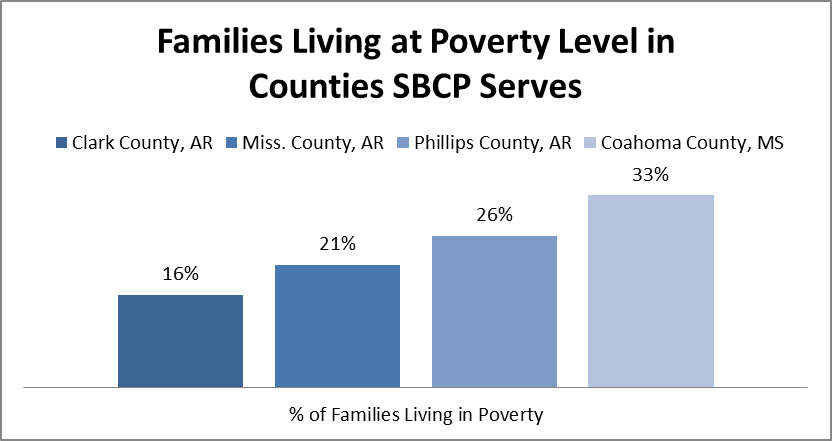Last month, a New York Times article, “In Climbing the Income Ladder, Location Matters,” examined income mobility within the United States. Based on this study, where a child grows up matters, which means achieving the American Dream is an uphill battle from the start for many children living in the Delta regions of Arkansas and Mississippi.
Researchers concluded that the following four factors affect a community’s income mobility.:
- Middle class dynamics
- Number of two-parent households
- Elementary and high school quality
- Civic engagement rates
According to this study and the statistics stated below, children living in Arkansas and Mississippi, especially in the counties served by Southern Bancorp Community Partners (SBCP) , are generally less economically mobile than other children throughout the country because the four factors needed to achieve income mobility are far below the national averages. And while the measures used below may not fully encompass each of the factors, they do serve as indicators of how each factor could impact the economic mobility of a child living in that area.
| Median Household Income[1] | % of Single Headed Households[2] | % of Population with At Least a High School Diploma[3] | Voter Turnout[4] | |
| Arkansas | $40,149 | 11.9% | 82.7% | 51.0% |
| Mississippi | $38,718 | 15.5% | 80.4% | 60.3% |
| United States | $52,762 | 11.3% | 85.4% | 57.5% |
| Median Household Income | % of Single Headed Households | % of Population with At Least a High School Diploma | Voter Turnout | |
| Clark County | $32,998 | 14.1% | 84.2% | 45.8% |
| Miss. County | $34,267 | 21.3% | 75.7% | 26.9% |
| Phillips County | $28,225 | 26.0% | 72.9% | 23.1% |
| Coahoma County | $26,050 | 28.2% | 75.0% | 36.3% |
As an example consistent with the study, a child who grows up in Coahoma County, Mississippi with parents who earn in the 10th percentile (approximately $16,000 annually) will only end up, on average, in the 28th percentile by age 30. However, if that child is raised in the same income bracket in San Francisco, he or she will likely be in the 41st percentile by age 30. This is where the four factors come into play in such a big way: despite the cost of living variances between Clarksdale and San Francisco, the child has greater economic mobility in San Francisco because that area supercedes the U.S. averages across the four measures.
In addition to the deficiences among the four indicators in Arkansas and Mississippi, the poverty rate is almost five percent higher than the U.S. average. With a a higher percentage of families living in poverty and in communities whose statistics predict low economic mobility, Arkansas and Mississippi children are less likely to pull out of poverty (see chart below).
But there is hope.
While not a specific goal of SBCP, raising income mobility is a by-product of overall poverty reduction, which is a central goal of our organization. We offer a variety of services through our asset building program, such as Individual Development Accounts (IDAs), Volunteer Income Tax Assistance (VITA), and credit and homebuyer counseling – all with the goal of helping families achieve financial stability. Our policy team contributes to this effort by working to ensure that Arkansas and Mississippi’s public policies allow and enable family economic security to thrive.
[1] U.S. Census Bureau, 2010.
[2] U.S. Census Bureau, 2010.
[3] U.S. Census Bureau, 2010.
[4] U.S. Elections Project, 2012.


